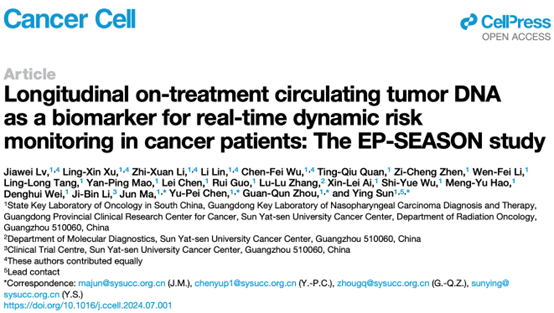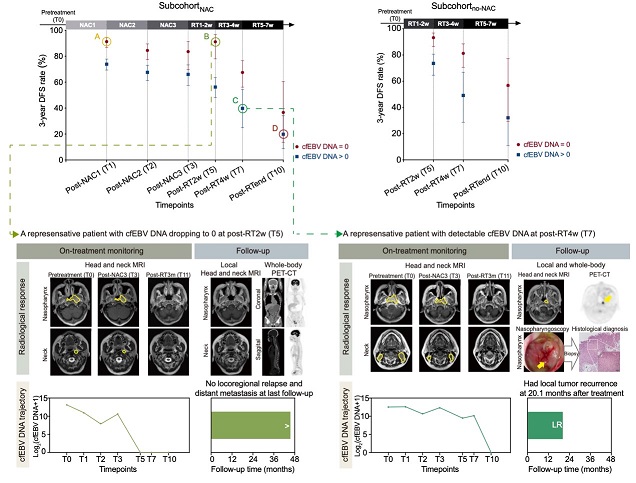Various anti-tumor treatments not only reduce tumor size but also trigger continuous evolution within tumor cells and their surrounding microenvironment. Notably, these changes can further impact the efficacy of anti-tumor treatments. Therefore, in clinical practice, recurrence risks of patients are not static but dynamically changing as treatment progresses. While repeated tumor tissue biopsies would theoretically provide the most reliable information for these changes, their invasive nature limits clinical application and patient acceptance. Consequently, there is currently a lack of simple and reliable methods for real-time dynamic risk assessment.
The use of body fluids as specimens for detecting tumor-related information is known as "liquid biopsy." As an emerging non-invasive tool for disease diagnosis and monitoring, liquid biopsy is primarily used in disease screening and the detection of residual disease. However, whether it can be applied to real-time monitoring of treatment efficacy and recurrence risk in cancer patients remains unclear.
Nasopharyngeal carcinoma (NPC) provides an ideal model here to investigate this issue, given that the cause-and-effect relationship between Epstein-Barr virus (EBV) infection and NPC has been established, and that cell-free EBV DNA (cfEBV DNA) released by NPC cells can be quantified in peripheral blood using an ultrasensitive quantitative polymerase chain reaction-based assay.
On July 25, 2024, Professor Sun Ying and Professor Ma Jun research group published a research article entitled ‘Longitudinal On-treatment Circulating Tumor DNA as A Biomarker for Real-Time Dynamic Risk Monitoring in Cancer Patients: The EP-SEASON Study’ in Cancer Cell (Figure 1). This study, using NPC as a model, successfully achieved real-time monitoring of patient treatment response and recurrence risk by dynamically tracking plasma cfEBV DNA, and provided a reliable biomarker for personalized treatment strategies.

Figure 1. The research article published in Cancer Cell
In this study, the researchers prospectively collected peripheral blood samples from 1000 NPC patients undergoing radical chemoradiotherapy at 12 different time points across pretreatment, three-week after each neoadjuvant chemotherapy (NAC) cycle, every-week during radiotherapy (RT), within one-week after RT completion, and 1-3 months after RT. The study comprehensively mapped the dynamic changes of cfEBV DNA during NAC and RT. Furthermore, the researchers discovered a close correlation between on-treatment cfEBV DNA and patient's treatment response and recurrence risk. Patients with rapid cfEBV DNA clearance exhibited significant tumor shrinkage and better treatment response, whereas those with persistently elevated cfEBV DNA had progressive tumor growth and poor treatment response. Additionally, the 3-year disease-free survival (DFS) rate of patients decreased with delayed cfEBV DNA clearance. However, it is noteworthy that patients who did not achieve cfEBV DNA clearance during NAC but achieved rapid clearance within the first two weeks of RT did not follow this rule. These patients had a 3-year DFS rate of 90%, comparable to those who achieved rapid cfEBV DNA clearance after the first NAC cycle (Figure 2). This indicates that even if a patient is unresponsive to NAC, timely transition to RT can still result in a low long-term recurrence risk for patients with sensitivity to RT. Based on these results, the researchers used an unsupervised clustering analysis to classify patients into different phenotypes of whole-course circulating tumor DNA changing dynamics (WCCD phenotypes) that exhibited distinct survival outcomes.

Figure 2. Clinical relevance of on-treatment cfEBV DNA with real-time treatment response and recurrence risks of NPC patients
Finally, the researchers explored potential effective treatment strategies for patients with cfEBV DNA clearance and non-clearance at each time point, and proposed utilizing on-treatment cfEBV DNA to help tailor individualized treatment strategies based on real-time recurrence risk, rather than the previous "one-size-fits-all" treatment model (Figure 3). Can risk-adapted treatment strategies guided by biomarkers improve patient survival? To answer this question, the researchers are conducting a phase II, multi-center, umbrella clinical trial (NCT04072107), which is currently ongoing and has completed patient enrollment. We look forward to this study yielding valuable insights and answers in the future.
Figure 3. Potential application of on-treatment cfEBV DNA in guiding personalized therapy
Professors Ying Sun, Jun Ma, Guanqun Zhou, and Yupei Chen from Sun Yat-sen University Cancer Center are the co-corresponding authors of this paper. Dr. Jiawei Lv, Ling-Xin Xu, Zhi-Xuan Li, Li Lin, and Chen-Fei Wu are the co-first authors of this paper.
Link to the original article: https://doi.org/10.1016/j.ccell.2024.07.001
Written by: Dr. Jiawei Lv, Department of Radiation Oncology, SYSUCC


